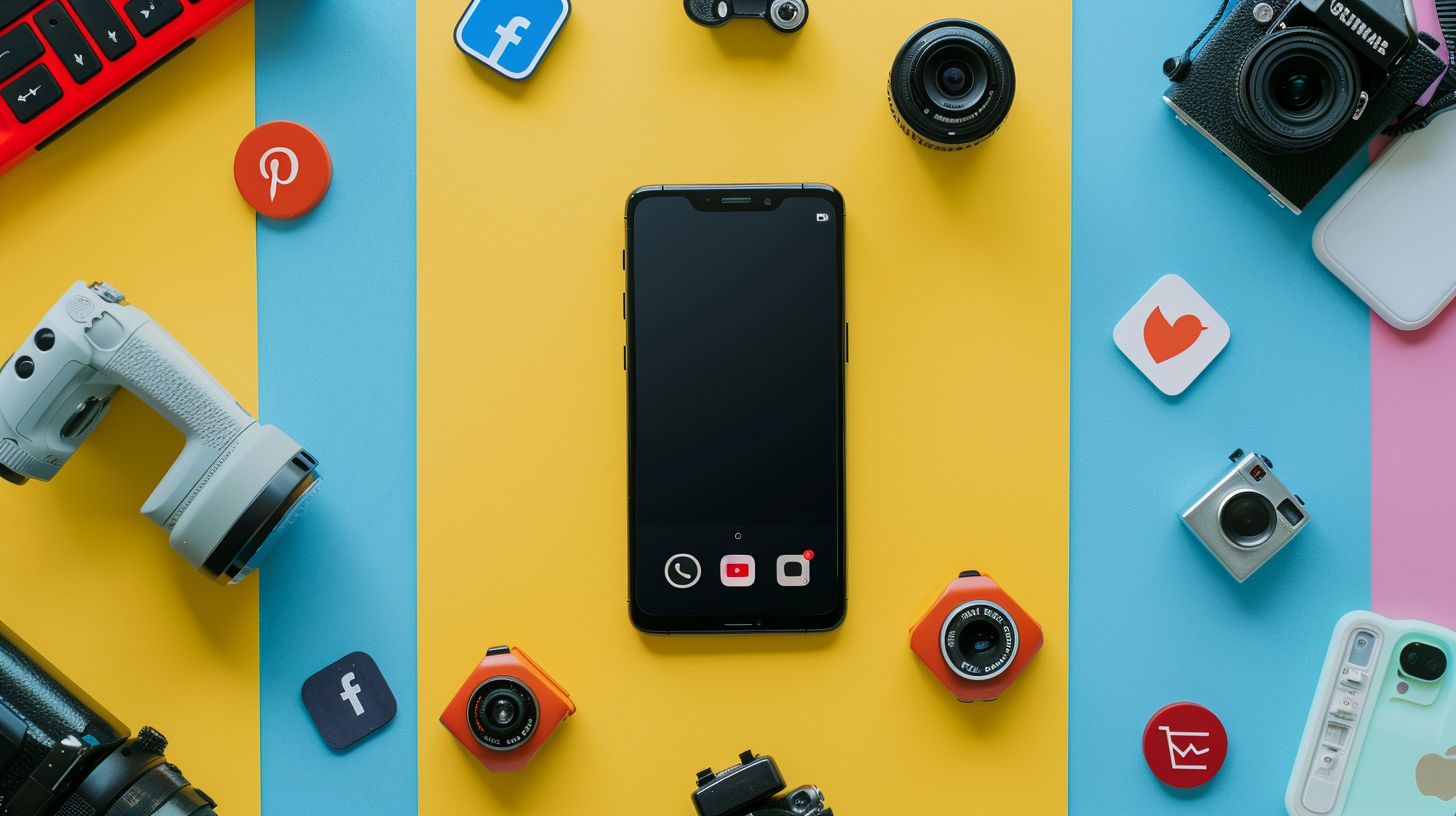

Ever find yourself mystified by the way your Instagram feed seems to whisper, “Just buy it”? Yes, you’re definitely not sailing in that boat alone. Countless folks find themselves swiping their cards or pledging allegiance to brands, all driven by those sleek squares and captivating stories on social media.
We’ve rolled up our sleeves and dug deep into the fascinating universe of social media advertising and its undeniable pull on our shopping hearts. Given that a whopping 54% of consumers have reported spending more time glued to their social feeds over the past two years, it’s no surprise these platforms are wielding considerable influence.
Our exploration has illuminated how beloved brands are utilizing these digital stages to sculpt your purchasing tendencies—not just through slick ‘shop now’ buttons nestled within posts but also via tailored chats with friendly bots.
Brace yourself for insights encompassing everything from the subtle psychological nudges behind influencer endorsements to the craving for realness in an age increasingly dominated by AI sophistication.
Eager for some enlightenment? Stick with us as we peel back the layers on mastering these forces can revolutionize how you connect online and uplift your engagement game. Let’s uncover those secrets together..
Key Takeaways
- Social media turns browsing into buying quickly, with platforms like Instagram and Facebook making shopping easy. People can buy things right from their feeds, speeding up how we shop.
- Talking to customers on social media is key. About 51% of people remember brands better when they chat back on platforms like Instagram or Twitter. Quick replies make a big difference.
- Stories on social media push us to buy things because they feel exclusive and urgent. Watching someone’s story about a product makes us want to buy it right away.
- Big numbers show how much influence there is in what our friends post online. Around 81% of us get swayed by what friends share on social media, showing the power of personal reviews.
- Influencers are changing the game, with nearly half of Twitter users buying something because an influencer recommended it. Their opinion matters a lot in what we decide to buy.
Understanding Social Media’s Influence on Consumer Behavior

We’ve seen firsthand how social media shapes the way people shop and make decisions. It’s more than just scrolling; it’s where we connect, learn, and choose what to buy next.
Direct Purchasing through Social Media
Social media has transformed the way we shop, making direct purchases just a click away. Our feeds now serve as storefronts where brands can display their products, leading to an instant buying decision.
This shift not only makes shopping more convenient but also integrates seamlessly into our daily social networking activities. With platforms like Instagram and Facebook incorporating shopping features directly into their interface, finding and buying products has never been easier.
The rise of social commerce sales is undeniable, projected to double to $1.224 billion by 2027. This trend underscores the crucial role social media plays in modern retail strategies.
By harnessing these platforms, businesses can reach their target audiences where they spend a significant portion of their time—scrolling through feeds and engaging with content that interests them.
As marketers, embracing this shift means adapting our sales tactics to include social media as a primary channel for customer engagement and transactions.
Expectation for Two-way Engagement
We understand that 51% of consumers recall brands most fondly when their social media pages engage directly with them. This statistic highlights a crucial change in customer behavior—we’re no longer just broadcasting messages; we’re starting conversations.
Quick, meaningful interactions are what people crave. They want to feel heard and valued, not just marketed to.
Engaging with customers on platforms like Instagram and Facebook has become an essential part of our strategy. We respond promptly because 76% of users expect fast replies to their queries or comments.
This two-way engagement fosters stronger relationships and builds trust between us and our audience. It’s not just about answering questions; it’s about showing we care and value their input.
Usage of Social Media for Customer Service
Our customers often turn to social media platforms for quick answers. They expect us to listen and respond swiftly. In fact, 76% of consumers value speedy responses from brands, and 70% look for personalized replies to their queries.
This shows the growing importance of active engagement on channels like Meta Messenger, Instagram, and TikTok.
We make it our mission to monitor these platforms closely for any customer communications. Collaboration across departments is key in delivering a unified customer experience that meets expectations at every touchpoint.
Using artificial intelligence aids us in providing timely and relevant responses, ensuring that we’re not just heard but also genuinely understood by our audience.
Demand for Authenticity in the Era of AI
We notice a growing trend where people crave real, authentic experiences online. Artificial intelligence (AI) brings many advantages to social media marketing, but it can also create a gap between brands and their audience.
Our strategy focuses on bridging this gap by emphasizing genuine interactions. We use AI to understand customer needs better but always pair it with human touch in communications. This approach helps us maintain trust and build stronger customer relationships.
In the era of AI, consumers are more perceptive and value honesty above all else. They can easily spot when messages feel too automated or insincere. That’s why we prioritize authentic storytelling and transparent communication in our social media campaigns.
By doing so, we not only meet our audience’s demand for authenticity but also deepen their connection with our brand. Real stories resonate more, creating a loyal community around shared values and experiences.
Desire for Transparency over Performative Activism
Consumers are getting smarter. They can tell the difference between real transparency and just showing off. Our research shows that 76% of customers expect fast and honest responses from brands on social media.
This means they want to see genuine actions, not just talk. They look for truth in what brands share online.
Brands need to be open about their values and how they operate. It’s not enough to post a catchy slogan or support a cause only once. People demand consistent evidence of a brand living up to its promises on social media platforms.
Authenticity leads to trust, and when consumers trust a brand, they’re more likely to become loyal customers.
Influence of Social Media Reviews
We recognize the power of social media reviews and their profound impact on buying decisions. A staggering 81% of people admit that their friends’ social media posts shape what they buy.
This tells us a lot about the strength of user-generated content. Reviews from real users act as powerful testimonials, often swaying others to follow suit.
Social proof is no small factor in today’s marketplace. Watching someone rave about a product on Instagram stories or reading through heartfelt tweets about customer satisfaction can turn viewers into buyers.
It makes the experience genuine, bridging gaps between skepticism and trust. Plus, with direct messages, it’s easier than ever for potential customers to ask peers questions about their purchases.
This interaction boosts confidence in decision-making, making every review an invaluable asset to both consumers and brands alike.
The Shortened Customer Journey Due to Social Media

Social media dramatically speeds up the customer journey. Customers now jump from discovering a product to buying it in just a few clicks. This shift means we need to be present and persuasive across all social platforms.
Our strategies focus on engaging content and responsive customer service. With 76% of consumers valuing quick brand responses, we prioritize personalized interactions. Social media’s power transforms browsing into buying faster than ever before.
The Power of Social Proof in Consumer Buying Decisions

We’ve noticed how our decisions are often influenced by what others think. This is where social proof comes into play, especially in consumer buying decisions. Seeing friends rave about a new product on Instagram accounts or reading glowing reviews online pushes us closer to making a purchase.
We’re more likely to trust personal recommendations and user testimonials than advertisements alone.
Incorporating customer experiences and reviews into marketing campaigns tap into this powerful psychological trigger. It builds credibility and reassures potential customers that they’re making the right choice.
Let’s leverage social media influencers, whose word seems as good as gold to their followers, further driving home the effectiveness of social proof in today’s digital marketplace.
The Impact of Influencers on Consumer Purchase Decisions

Influencers have changed the game in how we all make buying choices. Their impact is undeniable, with nearly half of Twitter users admitting to purchasing something directly because an influencer recommended it.
This shows a clear shift towards trusting individuals over traditional advertisements. We understand this evolution and craft our social media strategies to align with how influencers shape consumer behaviors.
Through engaging influencer marketing campaigns, we tap into the trust that followers have for their favorite online personalities. Almost 50% of purchases based on tweets tell us that the right word from the right person can lead to immediate action.
We leverage this by collaborating with influencers who resonate with our target audience, ensuring our messages are seen as authentic and trustworthy, thus driving sales and enhancing brand awareness through electronic word of mouth.
The Influence of Stories Feature on Consumer Buying Decisions

We’ve seen firsthand how the Stories feature across social networks like Instagram and Snapchat shapes consumer buying decisions. These fleeting snippets of content captivate audiences, creating a sense of urgency and exclusivity.
They’re not just photos or videos; they’re personal invitations from brands to consumers, showcasing products in real-life contexts. This immediacy encourages quick responses from viewers, turning them into buyers.
The power behind Stories lies in their authenticity and real-time nature, making every watch feel like an exclusive peek behind the curtain. Brands leverage this by highlighting limited-time offers, behind-the-scenes looks, and customer testimonials—transforming passive watchers into active participants.
The result? A stronger connection between brand and consumer often leads to direct purchases through simple swipes up or direct links embedded within these stories.
Most Influential Social Media Platforms

When it comes to shaping consumer behavior, platforms like Facebook, Instagram, TikTok, Twitter, and YouTube lead the charge. Dive in to uncover how these giants turn casual browsing into decisive buying.
Facebook dominates the social media landscape, boasting 2.7 billion monthly active users. It’s not just a platform for connecting friends and family; it has morphed into a powerful marketing tool.
With half of all social referrals and 64% of overall social revenue under its belt, Facebook has become essential in shaping consumer behavior and purchasing decisions.
In 2015 alone, Facebook influenced 52% of consumers’ online and offline purchases. This showcases its unparalleled impact on customer decisions from browsing to buying. By leveraging targeted ads, engaging content, and interactive features like chatbots for customer service, businesses can harness the power of Facebook to drive sales and build lasting customer relationships.
Instagram stands as a powerhouse in the social media landscape, shaping how we connect with brands and influencing our shopping behaviors. We see its impact through direct engagement between businesses and consumers.
A staggering 76% of users expect quick responses to their inquiries, highlighting the platform’s role in real-time customer service and satisfaction.
Employing artificial intelligence, Instagram enables smarter content creation and insightful social media reporting, enhancing user experiences while offering businesses powerful tools for reputation management.
Reviews shared on this platform significantly sway consumer purchases, underscoring the necessity for companies to manage their online presence meticulously. Through Instagram’s interactive features, brands have an unparalleled opportunity to build trust and foster loyalty among their followers.
TikTok
TikTok stands out as one of the most influential platforms in today’s digital marketing landscape. Its unique algorithm and creative content rapidly shift consumer behavior and purchasing decisions.
We see brands gaining recognition by actively engaging with their audience, responding to comments, and participating in trends. This level of interaction sets a new standard for customer service on social media.
Brands must stay agile to keep up with TikTok’s fast-paced environment. Quick responses and genuine engagement turn followers into customers. By adopting social customer service strategies for TikTok, companies can meet the changing expectations of their audience, ensuring a seamless experience that resonates well with the platform’s dynamic nature.
Twitter stands out as a powerful tool for brands aiming to connect quickly with their audience. It’s the go-to platform for sharing news, engaging in real-time conversations, and tapping into trending topics.
Our strategy leverages hashtags and direct tweets to join broader discussions, making our brand part of daily active users’ conversations.
We prioritize responsiveness on Twitter, understanding that 76% of consumers value swift replies to their inquiries. This aligns with employing effective social media monitoring tools to keep tabs on customer sentiment and address needs promptly.
Through such engagements, we not only foster stronger customer relationships but also boost our online presence significantly.
YouTube
YouTube stands as the second most visited platform globally, boasting over 2 billion logged-in users each month. This makes it an unrivaled stage for showcasing video content that resonates well with audiences across various demographics.
We leverage YouTube’s massive reach to position our brands right in front of potential customers, tapping into a stream of engaged viewers ready to explore what we have to offer.
With 80% of individuals turning to YouTube at the start of their buying journey for product reviews, it’s clear this platform plays a pivotal role in shaping consumer decisions. Our strategy includes crafting captivating video content that not only informs but entertains, making sure our products are seen and considered by those who matter the most — potential buyers.
By focusing on creating videos that answer real questions and offer genuine value, we connect with audiences on a level that text and images simply cannot match.
Ongoing Transformation: Social Media and Consumer Behavior

Social media continues to evolve at an astonishing pace, reshaping how we connect with brands and make purchasing decisions. Our habits as consumers are transforming right before our eyes, influenced by the latest trends in social media marketing.
Think about it—54% of us are spending more time on social platforms than we did two years ago. This surge in screen time is not just for casual browsing; it’s a deep dive into product research and experiencing brand stories firsthand.
Social commerce sales per buyer are on track to double by 2027, evidence of this unstoppable shift.
We’re partaking in this revolution, expecting instant responses from brands and seeking genuine engagement over mere transactions. Quick customer service responses matter more than ever—with 76% of consumers valuing swift replies to their needs.
Authenticity wins the game too, as demand grows for real interactions that cut through digital noise. With each scroll and click, we influence and get influenced, shaping a new era where every post can lead to a purchase decision or change our perception of brands forever.
Conclusion

We’ve seen how social media shapes the way we shop and connect with brands. From direct purchases on our feeds to expecting real talks with companies, these changes are big. Influencers and stories guide our choices too, making every share and like powerful.
Platforms like Instagram, TikTok, and YouTube lead the charge in this new era of online shopping. Remembering that being genuine and prompt wins customers’ hearts can set any brand apart.
Let’s embrace these shifts together—your next great buy or brand success story might just be a post away.
Frequently Asked Questions
1. How does social media advertising change the way we shop online?
Social media ads, from platforms like Instagram and TikTok, make us want to buy things right away! They show us cool products and deals that fit exactly what we like. This makes shopping online super easy and fun.
2. Can watching YouTube videos or livestreams influence what I buy?
Absolutely! When you watch your favorite YouTubers or livestream shopping events, you learn about new stuff. It’s like having a friend tell you what’s cool – making you more likely to buy it.
3. Why do companies use celebrities on social media to sell products?
Companies know we look up to celebrities and influencers. When they talk about a product on their Facebook page or Instagram, it feels trustworthy. So, we’re more interested in buying those products because our favorite stars love them too!
4. How do businesses use my feedback on social media?
Businesses pay close attention to what you say online, whether it’s a Google search or an Instagram direct message. They use this info to make better products and help customers faster – all thanks to technology that understands how we feel.
5. What is FOMO and how do advertisers use it in social media marketing?
FOMO means “Fear Of Missing Out.” Advertisers play into this by showing exclusive deals or limited-time offers on their social media accounts, making us worry we’ll miss out if we don’t act fast!
6. Do my online shopping habits get tracked by companies?
Yes! Companies keep an eye on what you search for and buy over the internet using special tools called analytics. This helps them figure out what people like us enjoy so they can offer more of those items.





